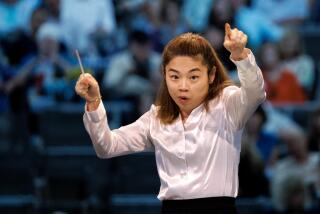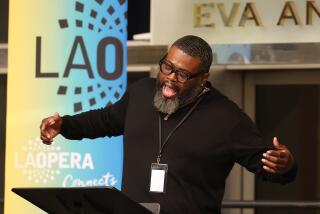Just who does set the bench mark?
WHEN Ian Bostridge, the English tenor, and Leif Ove Andsnes, the Norwegian pianist, take the stage at Walt Disney Concert Hall on Wednesday, they will be furthering a great tradition -- and a great debate.
Their program will feature lieder by Schubert and Beethoven, with the pianist accompanying the tenor. And the word âaccompanistâ stands at the center of this controversy: A successful lieder performance requires a delicate balance, and what sort of pianist best serves the art form remains in dispute.
âPlaying for a singer requires a lot of self-abnegation,â Bostridge said recently from his home in London. âThe voice is a fragile instrument, and you have to think about accommodating it.â
Andsnes, speaking from Norway, echoed those sentiments.
âWhen you work with an instrument, you donât have the danger of getting exhausted,â he said. âVoices have to be nurtured -- you canât just go on for hours and hours.â
That helps explain why thereâs a branch of pianism devoted to accompaniment. Its self-effacing practitioners, often scholars and coaches as well as players, are particularly attuned to the needs of singers. (Not for nothing did Gerald Moore, the 20th centuryâs most famous accompanist, title one of his memoirs âAm I Too Loud?â)
But these players are rarely known outside music circles. Instead, pianists such as Andsnes, Alfred Brendel, Andras Schiff and Vladimir Ashkenazy, who made their names as soloists, help fire the publicâs interest in lieder, often dramatically increasing the star power of a singer-pianist pairing.
Naturally, being elbowed aside by more celebrated musicians doesnât thrill professional accompanists. Graham Johnson -- who, like Andsnes, has performed and recorded with Bostridge and who was something of a mentor to him -- is arguably the most esteemed such pianist today, and a noted authority on art song.
âIf a solo pianist can do my job simply by opening up the score and playing the music better than me without thinking, then why should people take the trouble to study accompanying?â the London-based Johnson said via e-mail. âSomeone once had the gall to ask me to give a few tips to a solo pianist over the phone, as if this were all it would take to get the guy on the right track.â
Andsnes doesnât disagree about preparation. âOf course, you have to study the repertoire,â he said. âBut thatâs true with everything. If you devote your life to Beethoven, you are better at that than at playing Tchaikovsky.â
He takes exception, though, to the notion that only professional accompanists should partner singers. âTo be honest, Iâve never understood the distinction between accompanist and soloist,â he said. âIâm just a musician. And Iâve always found that you get the best result in lieder when you have a real pianist at the piano. Of course, itâs good to look at the text, but apart from that, itâs much the same as making chamber music with any other instrument.â
That term, âreal pianist,â cuts to the heart of the matter and is a phrase Johnson as good as anticipated.
âI get upset about this issue,â he wrote, âbecause it insultingly supposes that the art to which I have given my life is something anyone who is a good pianist can do. No, the implication is it can be done better by a soloist, because virtuosity governs all. And from there, itâs a short distance to consider an accompanist a pianistic butler, a loser who plays cringingly for tyrannical soloists in the hope of another crumb from the table.â
*
High-profile collaborators
THE pairing of lieder singers with more renowned musical figures is nothing new. Go back to the art formâs roots as a public affair and youâll find the revered Elena Gerhardt getting her start at 20 accompanied by Arthur Nikisch, then music director of the Berlin Philharmonic and the Leipzig Gewandhaus Orchestra.
In fact, several of the last centuryâs most acclaimed lieder singers formed nonexclusive partnerships with famous musicians, including English contralto Kathleen Ferrier (with conductor Bruno Walter as pianist) and German soprano Elisabeth Schwarzkopf (with Edwin Fischer, Walter Gieseking and, less successfully, Glenn Gould). But no one did more to focus the spotlight on the keyboard than Dietrich Fischer-Dieskau, the German baritone whose name is virtually synonymous with lieder singing and who in a 40-odd-year career ending in 1992 worked with players as diverse as Brendel, Daniel Barenboim, Christoph Eschenbach, Sviatoslav Richter and Leonard Bernstein.
Speaking from his London home, Brendel, who has also played for baritones Hermann Prey and, more recently, Matthias Goerne, credited Fischer-Dieskau with recasting the role of accompanist from lackey to collaborator.
âThe unequal partner is something of the past thanks to Fischer-Dieskau,â he said. âOnstage with Fischer-Dieskau, there was the ideal give and take. You knew that he listened to you as much as you listened to him.â
Yet singers face significant challenges working with pianists as famous, or more famous, than themselves. For American soprano Barbara Bonney, the issue is control. âIt can be very exciting to have the stimulus of a huge personality at the piano,â she said. âBut it can also be a bit of a tug of war when it comes to interpretation.â
And booking two popular artists is twice as hard as booking one. âItâs never easy to find dates with these people,â said Bostridge, referring not just to Andsnes but also to his other âstarâ piano partners: Mitsuko Uchida, conductor Antonio Pappano and composer Thomas Ades. âYou have to plan a long, long time in advance.â
Moreover, even solo pianists especially committed to lieder can indulge in this passion only so long. âWhat you have to realize when working with soloists,â said Bostridge, âis that however much they love song, their priorities lie elsewhere.â
Indeed, the well-received series of Schubert songs that Bostridge and Andsnes have recorded since 2001 is scheduled to conclude this year. Then Andsnes plans to turn his attention to Beethovenâs piano music.
Perhaps thatâs why Bostridge, presumably like many other singers, feels a certain loyalty to his longtime accompanist, Julius Drake, who will play 40 of the tenorâs 49 recital dates this season.
âEverything else is a bit adulterous, really,â said Bostridge. âJulius is used to me, and Iâm used to Julius. That has advantages.â
Asserting the benefits of both approaches, the tenor opts to celebrate diversity.
âGerald Moore couldnât play the piano as virtuosically as many colleagues, but thereâs something extraordinary about what he could do,â he said. âThey are different musical experiences, but one doesnât want to rank them. The important thing is that the music comes out fresh each time.â
*
Ian Bostridge/Leif Ove Andsnes
Where: Walt Disney Concert Hall, 111 S. Grand Ave., L.A.
When: 8 p.m. Wednesday
Price: $15 to $82
Contact: (323) 850-2000 or www.laphil.com
More to Read
The biggest entertainment stories
Get our big stories about Hollywood, film, television, music, arts, culture and more right in your inbox as soon as they publish.
You may occasionally receive promotional content from the Los Angeles Times.










